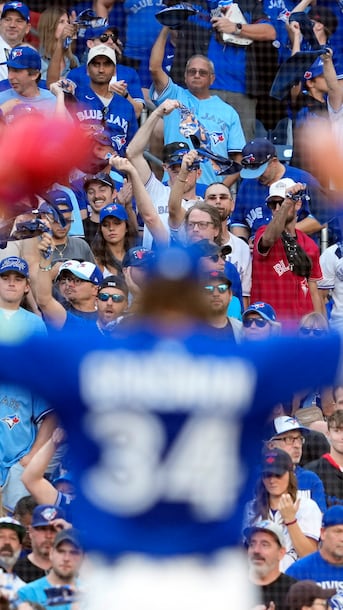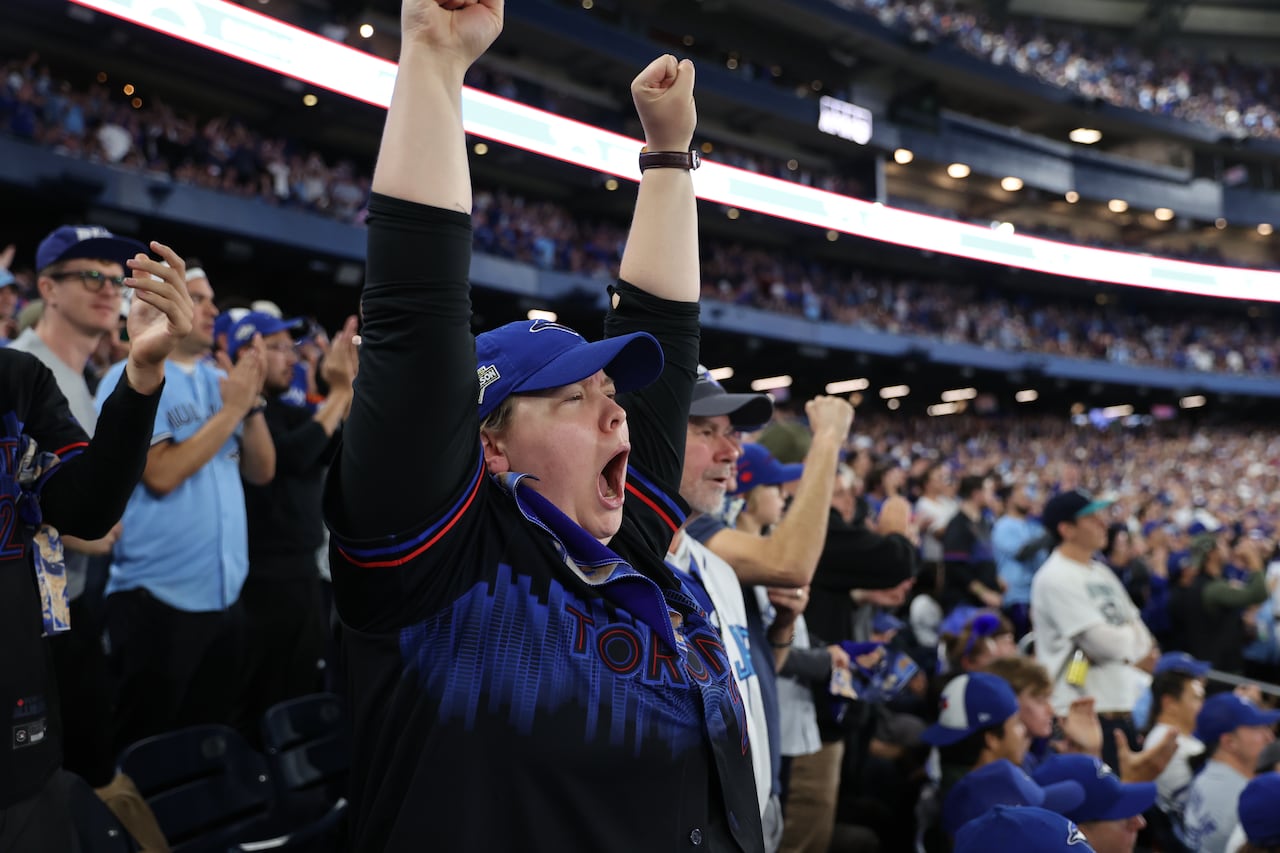The Toronto Blue Jays have given Robert Stanton something to look forward to every day.
“After the World Series is over, I’m not really sure what I’m going to do,” Stanton said, sitting on a park bench in downtown Toronto as a spatter of October rain drizzled on his blue cap embroidered with a vintage Jays logo.
The 70-year-old retired supply chain manager has been a baseball fan since he was five and he’s been entranced by the Cinderella story of the Jays’ most recent evolution, on their way to the World Series against the Los Angeles Dodgers.
Hundreds of kilometres away in St. John’s, N.L., Matthew Robbins, also a big baseball fan, said he feels like he’s had a spring in his step since earlier this week, when the Jays clinched their first World Series spot since 1993.
Watching more than 100 baseball games a season is usually a solitary activity for Robbins. But lately, his brother-in-law and sister have joined him and the online baseball discussion boards he contributes to have been lively.
That feeling of others appreciating the sport he loves has felt glorious, he said. It’s cut through the monotonous nature of life at this time of year, as the chill in the air deepens and the sky darkens earlier.
“I feel a part of something,” Robbins said.
The unifying pull of Jays fandom stretches coast-to-coast as Canada’s only Major League Baseball team, and experts say it’s actually very healthy, despite the Loonie Dogs, beers and cheesy nachos synonymous with watching the ball game.
 Joanne McLeod, left, and Hal Johnson, co-creators of BodyBreak, pose with Toronto Blue Jays mascot Ace, at Rogers Centre, in Toronto. (The Canadian Press)
Joanne McLeod, left, and Hal Johnson, co-creators of BodyBreak, pose with Toronto Blue Jays mascot Ace, at Rogers Centre, in Toronto. (The Canadian Press)
That collective identity creates a sense of belonging, which can mitigate isolation and loneliness at a time when those feelings are all too common.
Even Hal Johnson, host and co-creator of the BodyBreak segments that frequented Canadian television in the 1990s and encouraged viewers to be active in daily life, said he occasionally puts his health hat aside for the Jays and buys a bag of Ruffles barbecue chips.
“One of the great things about the Jays, about sporting events and about getting together, is not necessarily from the physical perspective, but from the emotional, mental-health perspective. It’s a way of how we feel good together,” Johnson, now 69, said from Muskoka, where he lives with his wife and fellow BodyBreak host Joanne McLeod.
When he was travelling last week, Johnson saw someone wearing a Jays hat and felt a connection with this stranger.
“It’s another great thing to unite us as Canadians,” he said.
Beyond that warm feeling of connection, registered psychologist Zarina Giannone said research shows being immersed in a sports community can actually improve a person’s sense of well-being.
WATCH | Jays fans weigh in on what sets them apart from Dodgers fans:
We asked some fans: What sets the Blue Jays’ fanbase apart from Dodgers?
Ahead of Toronto’s first World Series appearance since 1993, CBC Sports took to the streets of Toronto to ask people how being Canada’s team makes the Blue Jays differ from the Los Angeles Dodgers.
“The adoption of a group identity can fulfil our innate need for belongingness and social connection,” Giannone said.
Earlier this year, a study on football fans in Italy found a positive association between fandom and subjective well-being as a result of fostering a social identity with fellow fans.
It adds to numerous studies that have examined whether being a sports fan is good or bad for your health.
That includes a 2017 study that found the heart rate of Montreal Canadiens fans more than doubled during live games, equivalent to vigorous physical stress.
Research out of Japan in 2018 also found an increased risk of out-of-hospital cardiac arrests on days of professional baseball games.
In the context of mental health, Giannone said watching a game alongside other fans can actually be a way to escape daily life stressors by simply existing together, immersed in the shared experience, escaping an epidemic of loneliness that’s resulted from living in silos, rather than together.
 Fans cheer during Game 7 between the Toronto Blue Jays and the Seattle Mariners of the MLB’s ALCS at Rogers Centre in Toronto on Oct. 20, 2025. (Evan Mitsui/CBC)
Fans cheer during Game 7 between the Toronto Blue Jays and the Seattle Mariners of the MLB’s ALCS at Rogers Centre in Toronto on Oct. 20, 2025. (Evan Mitsui/CBC)
“That can be a really powerful psychological experience. By stepping away from the external world where there’s loss and tragedy, and I think it could just be so nourishing and restorative.”
Seconds after George Springer’s three-run homer Monday night, Michael Greer knew exactly where he wanted to be.
He dashed out the door of his apartment and took the subway to the Rogers Centre, where a sea of fans jumped in a mosh pit of joy celebrating outside the dome.
“It brings a sense of community, is the word for it.”

